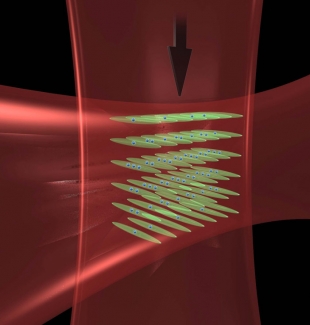In 2008-2009, much to their amazement,researchers working on the Jun Ye group’s neutral Sr optical atomic clock discovered tiny frequency shifts caused by colliding fermions! They figured out that the clock laser was interacting slightly differently with the Sr atoms inside a one-dimensional (pancake-shaped) trap. The light-atom interactions resulted in the atoms no longer being identical. And, once they were distinguishable, formerly unneighborly atoms were able to run into each other, compromising clock performance (See JILA Light & Matter, Spring 2009).
Ever since this discovery, the Ye group has been looking for strategies to reduce the number of atom-atom collisions and the resulting frequency shifts. Now, thanks to help from theorist Ana Maria Rey, the group has solved the problem of colliding fermions. In solving the problem, a team led by research associate Matt Swallows reduced the inaccuracy of the optical atomic clock arising from atomic collisions by 50-fold, reaching the level of 1 x 10-17! This result has eliminated the need for compromise between precision and accuracy in the on-going development of the group’s Sr-lattice clock, which uses many quantum particles.
In addition to Swallows, Rey, and Ye, the clock team included graduate students Michael Martin, Michael Bishof, and Sebastian Blatt as well as a visiting scientist Yige Lin. The team was presented with a JILA Scientific Award in August of 2010 for their accomplishment. Their breakthrough research was published online in Science Express on February 3.
To stop the fermions from colliding, the team used a new two-dimensional trap design that ensures strong interactions among the atoms. Paradoxically, strong interactions actually suppress collisions among the Sr atoms!
Here’s how: When Sr atoms are first loaded into the clock’s optical traps, they are identical and cannot collide. However, when the Sr atoms interact with the clock laser, some of them enter slightly different states and become distinguishable. Once they’re distinguishable, they can collide. In the old pancake trap, the atoms interacted weakly and had no trouble jumping back and forth between identical and distinguishable states. However, when atomic interactions get strong enough, a large energy gap appears between the two states. The energy gap prevents identical atoms from becoming distinguishable and colliding. It’s as if all the Sr atoms are forever frozen in identical states.
To create this quantum effect, Swallows and his colleagues sliced up the original pancakes with another laser beam, creating optical tubes that look like cigars. This trap confines the Sr atoms tightly. In fact, it squeezes the atoms so much that they enter the strongly interacting regime. It doesn’t push them as far into the new regime as possible, but it’s far enough to suppress most, if not all, of the frequency shifts. The new method should work even better in a trap with a larger number of atoms, because the suppression effect becomes more effective as the number of atoms per site and thus the interaction strength increases.
Now that they understand the quirky quantum mechanical behaviors of their clock atoms, Ye and his colleagues are working on developing a faster, more stable clock laser that is expected to further increase the clock’s accuracy and precision. - Julie Phillips



 The Physics Frontiers Centers (PFC) program supports university-based centers and institutes where the collective efforts of a larger group of individuals can enable transformational advances in the most promising research areas. The program is designed to foster major breakthroughs at the intellectual frontiers of physics by providing needed resources such as combinations of talents, skills, disciplines, and/or specialized infrastructure, not usually available to individual investigators or small groups, in an environment in which the collective efforts of the larger group can be shown to be seminal to promoting significant progress in the science and the education of students. PFCs also include creative, substantive activities aimed at enhancing education, broadening participation of traditionally underrepresented groups, and outreach to the scientific community and general public.
The Physics Frontiers Centers (PFC) program supports university-based centers and institutes where the collective efforts of a larger group of individuals can enable transformational advances in the most promising research areas. The program is designed to foster major breakthroughs at the intellectual frontiers of physics by providing needed resources such as combinations of talents, skills, disciplines, and/or specialized infrastructure, not usually available to individual investigators or small groups, in an environment in which the collective efforts of the larger group can be shown to be seminal to promoting significant progress in the science and the education of students. PFCs also include creative, substantive activities aimed at enhancing education, broadening participation of traditionally underrepresented groups, and outreach to the scientific community and general public.